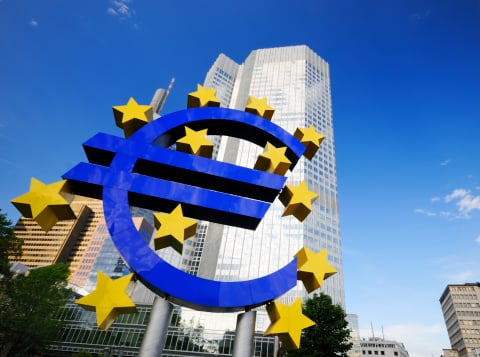Economy
What to Expect From European Central Bank and Draghi on Quantitative Easing
Published:
Last Updated:
Thursday is expected to bring word of expanded economic stimulus at the European Central Bank (ECB) meeting, with the likely timing being early 2015. Mario Draghi has already gone as far as to experiment with negative rates, and the ECB has already telegraphed that it will undertake an effort to purchase asset-backed securities from European banks. Source: Thinkstock
Source: Thinkstock
The big question is what sort of quantitative easing we can generally expect from Thursday’s news announcement. The hope is that the ECB will start buying up sovereign debt from the eurozone nations that is held on bank balance sheets.
The latest inflation reading having come it at just 0.3% has left Team Draghi with a huge gap between inflation (or deflation) and its targeted goal of 2% inflation. If the ECB does not commit to quantitative easing on Thursday, the markets almost certainly will be disappointed.
Another risk for Europe ahead is that oil prices remain low. This would only act to keep a pressure against price rises, or at least certainly keep pressure on the transportation and production side of the economic equation. The euro currency has also just hit a new two-year low against the U.S. dollar.
The big question is more than likely “by how much and when” more quantitative easing will start rather than “if” new quantitative easing can be expected. Anything under a couple hundred billion euros (and likely much more) and any time frame later than early in 2015 is not likely to move the needle positively at all to help. That being said, the euro, gold and European bond yields will all be hanging on a thread ahead of the ECB decision. Perhaps the biggest equity move to watch for in exchange traded funds (ETFs) will be in the WisdomTree Europe Hedged Equity ETF (NYSEMKT: HEDJ). This fund has been taking in new assets galore as investors are expecting a Japanese-style quantitative easing effort.
Now keep in mind that even Italy has its 10-year sovereign debt yield trading under 2%. That puts it in the same club as Germany, France, Netherlands, Belgium — and even Spain and Ireland! The 10-year Treasury note in the United States yields almost 2.30% now. Many of these nations would not have yields less than the United States if it were not for such dismal growth and inflation prospects and the hope for more quantitative easing.
The CIA World Factbook represented that the European Union’s 2013 gross domestic product was $15.85 trillion on a purchasing power parity basis, making it the second largest economy in the world — although that would be the largest economy in the world if its growth issues were on track and if it was not still dealing with so many problems.
ALSO READ: 5 Big Imminent DJIA Dividend Hikes to Bank On
Below are key levels for the asset prices we will be watching most closely if the ECB does not commit handily to additional quantitative easing:
Finding a qualified financial advisor doesn’t have to be hard. SmartAsset’s free tool matches you with up to 3 fiduciary financial advisors in your area in 5 minutes. Each advisor has been vetted by SmartAsset and is held to a fiduciary standard to act in your best interests. If you’re ready to be matched with local advisors that can help you achieve your financial goals, get started now.
Thank you for reading! Have some feedback for us?
Contact the 24/7 Wall St. editorial team.